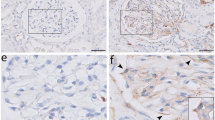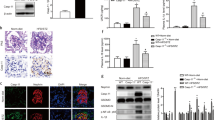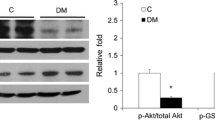Abstract
Previous studies have demonstrated the importance of monocyte chemoattractant protein-1 (MCP-1) in the pathogenesis of diabetic nephropathy in terms of inflammation, but the direct role of the MCP-1/CCR2 system on podocyte apoptosis under diabetic conditions has never been explored. In vitro, mouse podocytes were exposed to a medium containing 30 mM glucose (HG) with or without CCR2 siRNA or CCR2 inhibitor (RS102895). Podocytes were also treated with MCP-1 or TGF-β1 with or without anti-TGF-β1 antibody, CCR2 siRNA, or CCR2 inhibitor. In vivo, 20 db/m and 20 db/db mice were divided into two groups, and ten mice from each group were treated with RS102895. Western blot and Hoechst 33342 or TUNEL staining were performed to identify apoptosis. HG-induced apoptosis and TGF-β1 levels were significantly abrogated by CCR2 inhibition. In addition, treatment with MCP-1 directly induced apoptosis via CCR2. Moreover, TGF-β1- and MCP-1-induced apoptosis were significantly ameliorated by the inhibition of CCR2 and anti-TGF-β1 antibody, respectively. Glomerular expression of cleaved caspase-3 and apoptotic cells within glomeruli were also significantly increased in db/db mice compared to db/m mice, and these increases were significantly attenuated in db/db + RS102895 mice. These results suggest that interactions between the MCP-1/CCR2 system and TGF-β1 may contribute to podocyte apoptosis under diabetic conditions.










Similar content being viewed by others
References
Furuta T, Saito T, Ootaka T, Soma J, Obara K, Abe K, Yoshinaga K (1993) The role of macrophages in diabetic glomerulosclerosis. Am J Kidney Dis 21:480–485
Young BA, Johnson RJ, Alpers CE, Eng E, Gordon K, Floege J, Couser WG, Seidel K (1995) Cellular events in the evolution of experimental diabetic nephropathy. Kidney Int 47:935–944
Segerer S, Nelson PJ, Schlondorff D (2000) Chemokines, chemokine receptors, and renal disease: From basic science to pathophysiologic and therapeutic studies. J Am Soc Nephrol 11:152–176
Rovin BH, Yoshiumura T, Tan L (1992) Cytokine-induced production of monocyte chemoattractant protein-1 by cultured human mesangial cells. J Immunol 148:2148–2153
Han SY, So GA, Jee YH, Han KH, Kang YS, Kim HK, Kang SW, Han DS, Han JY, Cha DR (2004) Effect of retinoic acid in experimental diabetic nephropathy. Immunol Cell Biol 82:568–576
Chiarelli F, Cipollone F, Mohn A, Marini M, Iezzi A, Fazia M, Tumini S, De Cesare D, Pomilio M, Pierdomenico SD, Di Gioacchino M, Cuccurullo F, Mezzetti A (2002) Circulating monocyte chemoattractant protein-1 and early development of nephropathy in type 1 diabetes. Diabetes Care 25:1829–1834
Banba N, Nakamura T, Matsumura M, Kuroda H, Hattori Y, Kasai K (2000) Possible relationship of monocyte chemoattractant protein-1 with diabetic nephropathy. Kidney Int 58:684–690
Morii T, Fujita H, Narita T, Shimotomai T, Fujishima H, Yoshioka N, Imai H, Kakei M, Ito S (2003) Association of monocyte chemoattractant protein-1 with renal tubular damage in diabetic nephropathy. J Diabetes Complications 17:11–15
Chow F, Ozols E, Nikolic-Paterson DJ, Atkins RC, Tesch GH (2004) Macrophages in mouse type 2 diabetic nephropathy: correlation with diabetic state and progressive renal injury. Kidney Int 65:116–128
Chow FY, Nikolic-Paterson DJ, Ozols E, Atkins RC, Rollin BJ, Tesch GH (2006) Monocyte chemoattractant protein-1 promotes the development of diabetic renal injury in streptozotocin-treated mice. Kidney Int 69:73–80
Janssen U, Sowa E, Marchand P, Floege J, Phillips AO, Radeke HH (2002) Differential expression of MCP-1 and its receptor CCR2 in glucose primed human mesangial cells. Nephron 92:797–806
Burt D, Salvidio G, Tarabra E, Barutta F, Pinach S, Dentelli P, Camussi G, Perin PC, Gruden G (2007) The monocyte chemoattractant protein-1/cognate CC chemokine receptor 2 system affects cell motility in cultured human podocytes. Am J Pathol 171:1789–1799
Lee EY, Chung CH, Khoury CC, Yeo TK, Pyagay PE, Wang A, Chen S (2009) The monocyte chemoattractant protein-1/CCR2 loop, inducible by TGF-β, increases podocyte motility and albumin permeability. Am J Physiol Renal Physiol 297:F85–F94
Park J, Ryu DR, Li JJ, Jung DS, Kwak SJ, Lee SH, Yoo TH, Han SH, Lee JE, Kim DK, Moon SJ, Kim K, Han DS, Kang SW (2008) MCP-1/CCR2 system is involved in high glucose-induced fibronectin and type IV collagen expression in cultured mesangial cells. Am J Physiol Renal Physiol 295:F749–F757
Susztak K, Raff AC, Schiffer M, Bottinger EP (2006) Glucose-induced reactive oxygen species cause apoptosis of podocytes and podocyte depletion at the onset of diabetic nephropathy. Diabetes 55:225–233
Verzola D, Gandolfo MT, Ferrario F, Rastaldi MP, Villaggio B, Gianiorio F, Giannoni M, Rimoldi L, Lauria F, Miji M, Deferrari G, Garibotto G (2007) Apoptosis in the kidneys of patients with type II diabetic nephropathy. Kidney Int 72:1262–1272
Steffes MW, Schmidt D, McCrery R, Basgen JM (2001) Glomerular cell number in normal subjects and in type 1 diabetic patients. Kidney Int 59:2104–2113
Schiffer M, Bitzer M, Roberts IS, Kopp JB, ten Dijke P, Mundel P, Bottinger EP (2001) Apoptosis in podocytes induced by TGF-β and Smad7. J Clin Invest 108:807–816
Kalehua AN, Nagel JE, Whelchel LM, Gides JJ, Pyle RS, Smith RJ, Kusiak JW, Taub DD (2004) Monocyte chemoattractant protein-1 and macrophage inflammatory protein-2 are involved in both excitotoxin-induced neurodegeneration and regeneration. Exp Cell Res 297:197–211
Zhou L, Azfer A, Niu J, Graham S, Choudhury M, Adamski FM, Younce C, Binkley PF, Kolattukudy PE (2006) Monocyte chemoattractant protein-1 induces a novel transcription factor that causes cardiac myocyte apoptosis and ventricular dysfunction. Circ Res 98:1177–1185
Nakazawa T, Hisatomi T, Nakazawa C, Noda K, Maruyama K, She H, Matsubara A, Miyahara S, Nakao S, Yin Y, Benowitz L, Hafezi-Moghadam A, Miller JW (2007) Monocyte chemoattractant protein 1 mediates retinal detachment-induced photoreceptor apoptosis. Proc Natl Acad Sci U S A 104:2425–2430
Younce CW, Kolattukudy PE (2010) MCP-1 causes cardiomyoblast death via autophagy resulting from er stress caused by oxidative stress generated by inducing a novel zinc-finger protein, MCPIP. Biochem J 426:43–53
Mundel P, Reiser J, Zuniga Mejia Borja A, Pavenstadt H, Davidson GR, Kriz W, Zeller R (1997) Rearrangements of the cytoskeleton and cell contacts induce process formation during differentiation of conditionally immortalized mouse podocyte cell lines. Exp Cell Res 236:248–258
Lois C, Refaeli Y, Qin XF, Van Parijs L (2001) Retroviruses as tools to study the immune system. Curr Opin Immunol 13:496–504
Xu ZG, Yoo TH, Ryu DR, Park HC, Ha SK, Han DS, Adler SG, Natarajan R, Kang SW (2005) Angiotensin II receptor blocker inhibits p27kip1 expression in glucose-stimulated podocytes and in diabetic glomeruli. Kidney Int 67:944–952
Lee SC, Han SH, Li JJ, Lee SH, Jung DS, Kwak SJ, Kim SH, Kim DK, Yoo TH, Kim JH, Chang SH, Han DS, Kang SW (2009) Induction of heme oxygenase-1 protects against podocyte apoptosis under diabetic conditions. Kidney Int 76:838–848
Giunti S, Pinach S, Arnaldi L, Viberti G, Perin PC, Camussi G, Gruden G (2006) The MCP-1/CCR2 system has direct proinflammatory effects in human mesangial cells. Kidney Int 69:856–863
Giunti S, Tesch GH, Pinach S, Burt DJ, Cooper ME, Cavallo-Perin P, Camussi G, Gruden G (2008) Monocyte chemoattractant protein-1 has prosclerotic effects both in a mouse model of experimental diabetes and in vitro in human mesangial cells. Diabetologia 51:198–207
Tarabra E, Giunti S, Barutta F, Salvidio G, Burt D, Deferrari G, Gambino R, Vergola D, Pinach S, Perin PC, Camussi G, Gruden G (2009) Effect of the monocyte chemoattractant protein-1/CC chemokine receptor 2 system on nephrin expression in streptozotocin-treated mice and human cultured podocytes. Diabetes 58:2109–2118
Reid S, Ritchie A, Boring L, Gosling J, Cooper S, Hangoc G, Charo IF, Broxmeyer HE (1999) Enhanced myeloid progenitor cell cycling and apoptosis in mice lacking the chemokine receptor, CCR2. Blood 93:1524–1533
Lee JS, Yang EJ, Kim IS (2009) The roles of MCP-1 and protein kinase Cδ activation in human eosinophilic leukemia EoL-1 cells. Cytokine 48:186–195
Schneider A, Panzer U, Zahner G, Wenzel U, Wolf G, Thaiss F, Helmchen U, Stahl RA (1999) Monocyte chemoattractant protein-1 mediates collagen deposition in experimental glomerulonephritis by transforming growth factor-β. Kidney Int 56:135–144
Wolf G, Jocks T, Zahner G, Panzer U, Stahl RA (2002) Existence of a regulatory loop between MCP-1 and TGF-β in glomerular immune injury. Am J Physiol Renal Physiol 283:F1075–F1084
Mitu GM, Wang S, Hirschberg R (2007) BMP7 is a podocyte survival factor and rescues podocytes from diabetic injury. Am J Physiol Renal Physiol 293:F1641–F1648
Sanchez-Niño MD, Benito-Martin A, Gonçalves S, Sanz AB, Ucero AC, Izquierdo MC, Ramos AM, Berzal S, Selgas R, Ruiz-Ortega M, Egido J, Ortiz A (2010) TNF superfamily: a growing saga of kidney injury modulators. Mediators Inflamm 2010; pii: 182958
Morse E, Schroth J, You YH, Pizzo DP, Okada S, Ramachandrarao S, Vallon V, Sharma K, Cunard R (2010) TRB3 is stimulated in diabetic kidneys, regulated by the ER stress marker CHOP, and is a suppressor of podocyte MCP-1. Am J Physiol Renal Physiol 299:F965–F972
Iglesias-de la Cruz MC, Ziyadeh FN, Isono M, Kouahou M, Han DC, Kalluri R, Mundel P, Chen S (2002) Effects of high glucose and TGF-β1 on the expression of collagen IV and vascular endothelial growth factor in mouse podocytes. Kidney Int 62:901–913
Kang YS, Lee MH, Song HK, Ko GJ, Kwon OS, Lim TK, Kim SH, Han SY, Han KH, Lee JE, Han JY, Kim HK, Cha DR (2010) CCR2 antagonism improves insulin resistance, lipid metabolism, and diabetic nephropathy in type 2 diabetic mice. Kidney Int 78:883–894
Acknowledgments
This study was supported by Basic Science Research Program through the National Research Foundation of Korea (NRF) funded by the Ministry of Education, Science, and Technology (2009-0089803), the BK21 (Brain Korea 21) Project for Medical Sciences, Yonsei University, and the National Research Foundation of Korea (NRF) grant funded by the Korea government (MEST) (No. 2011-0030711).
Conflict of interest statement
None declared.
Author information
Authors and Affiliations
Corresponding author
Additional information
B.Y. Nam, J. Paeng, and S.H. Kim are contributed equally to this work.
Rights and permissions
About this article
Cite this article
Nam, B.Y., Paeng, J., Kim, S.H. et al. The MCP-1/CCR2 axis in podocytes is involved in apoptosis induced by diabetic conditions. Apoptosis 17, 1–13 (2012). https://doi.org/10.1007/s10495-011-0661-6
Published:
Issue Date:
DOI: https://doi.org/10.1007/s10495-011-0661-6




